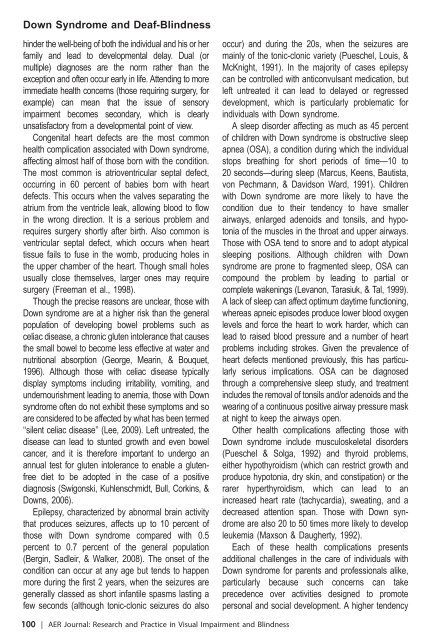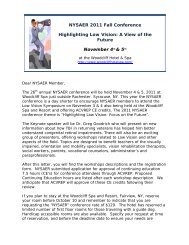Association for Education and Rehabilitation of the ... - AER Online
Association for Education and Rehabilitation of the ... - AER Online
Association for Education and Rehabilitation of the ... - AER Online
You also want an ePaper? Increase the reach of your titles
YUMPU automatically turns print PDFs into web optimized ePapers that Google loves.
Down Syndrome <strong>and</strong> Deaf-Blindness<br />
hinder <strong>the</strong> well-being <strong>of</strong> both <strong>the</strong> individual <strong>and</strong> his or her<br />
family <strong>and</strong> lead to developmental delay. Dual (or<br />
multiple) diagnoses are <strong>the</strong> norm ra<strong>the</strong>r than <strong>the</strong><br />
exception <strong>and</strong> <strong>of</strong>ten occur early in life. Attending to more<br />
immediate health concerns (those requiring surgery, <strong>for</strong><br />
example) can mean that <strong>the</strong> issue <strong>of</strong> sensory<br />
impairment becomes secondary, which is clearly<br />
unsatisfactory from a developmental point <strong>of</strong> view.<br />
Congenital heart defects are <strong>the</strong> most common<br />
health complication associated with Down syndrome,<br />
affecting almost half <strong>of</strong> those born with <strong>the</strong> condition.<br />
The most common is atrioventricular septal defect,<br />
occurring in 60 percent <strong>of</strong> babies born with heart<br />
defects. This occurs when <strong>the</strong> valves separating <strong>the</strong><br />
atrium from <strong>the</strong> ventricle leak, allowing blood to flow<br />
in <strong>the</strong> wrong direction. It is a serious problem <strong>and</strong><br />
requires surgery shortly after birth. Also common is<br />
ventricular septal defect, which occurs when heart<br />
tissue fails to fuse in <strong>the</strong> womb, producing holes in<br />
<strong>the</strong> upper chamber <strong>of</strong> <strong>the</strong> heart. Though small holes<br />
usually close <strong>the</strong>mselves, larger ones may require<br />
surgery (Freeman et al., 1998).<br />
Though <strong>the</strong> precise reasons are unclear, those with<br />
Down syndrome are at a higher risk than <strong>the</strong> general<br />
population <strong>of</strong> developing bowel problems such as<br />
celiac disease, a chronic gluten intolerance that causes<br />
<strong>the</strong> small bowel to become less effective at water <strong>and</strong><br />
nutritional absorption (George, Mearin, & Bouquet,<br />
1996). Although those with celiac disease typically<br />
display symptoms including irritability, vomiting, <strong>and</strong><br />
undernourishment leading to anemia, those with Down<br />
syndrome <strong>of</strong>ten do not exhibit <strong>the</strong>se symptoms <strong>and</strong> so<br />
are considered to be affected by what has been termed<br />
‘‘silent celiac disease’’ (Lee, 2009). Left untreated, <strong>the</strong><br />
disease can lead to stunted growth <strong>and</strong> even bowel<br />
cancer, <strong>and</strong> it is <strong>the</strong>re<strong>for</strong>e important to undergo an<br />
annual test <strong>for</strong> gluten intolerance to enable a glutenfree<br />
diet to be adopted in <strong>the</strong> case <strong>of</strong> a positive<br />
diagnosis (Swigonski, Kuhlenschmidt, Bull, Corkins, &<br />
Downs, 2006).<br />
Epilepsy, characterized by abnormal brain activity<br />
that produces seizures, affects up to 10 percent <strong>of</strong><br />
those with Down syndrome compared with 0.5<br />
percent to 0.7 percent <strong>of</strong> <strong>the</strong> general population<br />
(Bergin, Sadleir, & Walker, 2008). The onset <strong>of</strong> <strong>the</strong><br />
condition can occur at any age but tends to happen<br />
more during <strong>the</strong> first 2 years, when <strong>the</strong> seizures are<br />
generally classed as short infantile spasms lasting a<br />
few seconds (although tonic-clonic seizures do also<br />
100 | <strong>AER</strong> Journal: Research <strong>and</strong> Practice in Visual Impairment <strong>and</strong> Blindness<br />
occur) <strong>and</strong> during <strong>the</strong> 20s, when <strong>the</strong> seizures are<br />
mainly <strong>of</strong> <strong>the</strong> tonic-clonic variety (Pueschel, Louis, &<br />
McKnight, 1991). In <strong>the</strong> majority <strong>of</strong> cases epilepsy<br />
can be controlled with anticonvulsant medication, but<br />
left untreated it can lead to delayed or regressed<br />
development, which is particularly problematic <strong>for</strong><br />
individuals with Down syndrome.<br />
A sleep disorder affecting as much as 45 percent<br />
<strong>of</strong> children with Down syndrome is obstructive sleep<br />
apnea (OSA), a condition during which <strong>the</strong> individual<br />
stops breathing <strong>for</strong> short periods <strong>of</strong> time—10 to<br />
20 seconds—during sleep (Marcus, Keens, Bautista,<br />
von Pechmann, & Davidson Ward, 1991). Children<br />
with Down syndrome are more likely to have <strong>the</strong><br />
condition due to <strong>the</strong>ir tendency to have smaller<br />
airways, enlarged adenoids <strong>and</strong> tonsils, <strong>and</strong> hypotonia<br />
<strong>of</strong> <strong>the</strong> muscles in <strong>the</strong> throat <strong>and</strong> upper airways.<br />
Those with OSA tend to snore <strong>and</strong> to adopt atypical<br />
sleeping positions. Although children with Down<br />
syndrome are prone to fragmented sleep, OSA can<br />
compound <strong>the</strong> problem by leading to partial or<br />
complete wakenings (Levanon, Tarasiuk, & Tal, 1999).<br />
A lack <strong>of</strong> sleep can affect optimum daytime functioning,<br />
whereas apneic episodes produce lower blood oxygen<br />
levels <strong>and</strong> <strong>for</strong>ce <strong>the</strong> heart to work harder, which can<br />
lead to raised blood pressure <strong>and</strong> a number <strong>of</strong> heart<br />
problems including strokes. Given <strong>the</strong> prevalence <strong>of</strong><br />
heart defects mentioned previously, this has particularly<br />
serious implications. OSA can be diagnosed<br />
through a comprehensive sleep study, <strong>and</strong> treatment<br />
includes <strong>the</strong> removal <strong>of</strong> tonsils <strong>and</strong>/or adenoids <strong>and</strong> <strong>the</strong><br />
wearing <strong>of</strong> a continuous positive airway pressure mask<br />
at night to keep <strong>the</strong> airways open.<br />
O<strong>the</strong>r health complications affecting those with<br />
Down syndrome include musculoskeletal disorders<br />
(Pueschel & Solga, 1992) <strong>and</strong> thyroid problems,<br />
ei<strong>the</strong>r hypothyroidism (which can restrict growth <strong>and</strong><br />
produce hypotonia, dry skin, <strong>and</strong> constipation) or <strong>the</strong><br />
rarer hyperthyroidism, which can lead to an<br />
increased heart rate (tachycardia), sweating, <strong>and</strong> a<br />
decreased attention span. Those with Down syndrome<br />
are also 20 to 50 times more likely to develop<br />
leukemia (Maxson & Daugherty, 1992).<br />
Each <strong>of</strong> <strong>the</strong>se health complications presents<br />
additional challenges in <strong>the</strong> care <strong>of</strong> individuals with<br />
Down syndrome <strong>for</strong> parents <strong>and</strong> pr<strong>of</strong>essionals alike,<br />
particularly because such concerns can take<br />
precedence over activities designed to promote<br />
personal <strong>and</strong> social development. A higher tendency







